Bay Area
Town Hall Says Don’t Let Fisher’s Stadium Project Choke the Port of Oakland
Post publisher Paul Cobb said the newspaper has been discussing the different sides of this issue and hopes to help clear up the confusing messages the public is receiving about whether this project will help or damage the prospects of good jobs for Oaklanders.
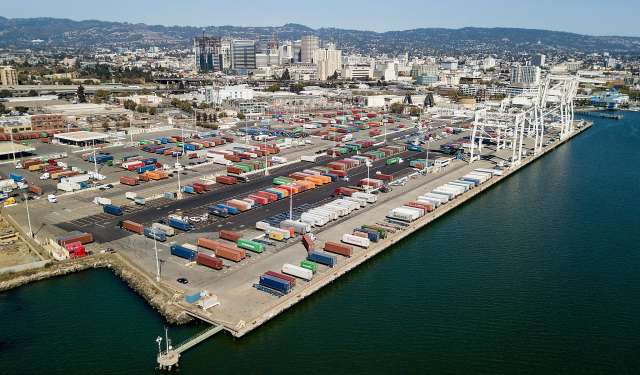
A town hall meeting this week examined the negative consequences of placing John Fisher’s privatized, multibillion dollar real estate development on publicly owned land at the Port of Oakland, the region’s thriving and growing economic engine.
More than 100 people attended the town hall on Wednesday, which was live on Zoom and Facebook. Councilmembers Carroll Fife and Noel Gallo were among those who attended.
Speakers included voices of those who are directly impacted by the project: members of the longshore union, the ILWU, who said the project was a dangerous threat to the livelihood of port workers, over 70% of whom are Black; representatives of the Pacific Merchants Shipping Association and several of the largest businesses based at the port; and Paul Cobb, publisher of the Oakland Post.
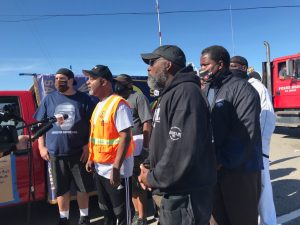
ILWU Local 10 President Trent Willis, with other union members, speaks on June 19, 2020 about shutting down West Coast ports for Juneteenth. Photo by Workers World, Judy Greenspan.
Though called a baseball stadium project, the massive, luxury real estate development is what backers have called a “city within a city.” Besides a stadium, the plan calls for 3,000 luxury condominiums, with no guaranteed affordable housing; 1.5 million square feet of high-rise office space; a 400-room hotel; retail shopping; and a performance venue with seating for 3,500.
Linda Adams, a member of the ILWU who is who is one of the workers “responsible for moving the cargo on a daily basis,” said, they are “compromising our jobs.”
“They say they can build these high rise luxury condos, and (we) can work around them. But we’re moving cargo around the clock, (with) thousands of (workers), trucks and cargo coming into the port.” She pointed out that luxury tenants will go to court to stop the noise, pollution, bright lights and thousands of daily trucks and railroads that are wrecking their days and nights, pushing companies to leave Oakland for other West Coast ports.
Susan Ransom, representing SSA Marine, the Port’s largest tenant, said the Port has over 84,000 total employees and moves the products on which everyone depends – food, household goods and medical supplies
“We have grave concerns about the A’s (stadium) project,” she said. ”We operate 24/7, (our work) would not be stopped during a game” or for a fireworks display.
Mike Jacob of the Pacific Merchants Shipping Association which represents employers, said, “We have real issue here. Do we want to preserve our industrial base? Do we want to make Oakland a smaller kid’s version of San Francisco? Should Oakland continue to be a blue-collar city with good blue-collar jobs.”
Jacob said he was talking with the A’s, but they stopped meeting with him in 2019 when he raised concerns that would be expensive to mitigate. “You don’t have to be either pro- or anti-baseball to be pro-port,” he said.
ILWU business agent Aaron Wright, broadcasting live from on top of a port crane, showed the basin where ships have to turn around, which would be impacted by the project, and the Howard Terminal property, where thousands of trucks park daily instead of where they parked in the past on West Oakland and other neighborhoods’ residential streets. “One day at the port can do more for the economy than all of the team’s home games,” he said. “You can’t bring in thousands of sports fans to block all of this.”
Andrea Luna Bocanegra, who works for a manufacturing company that does business with the port, said that disrupting shipping at the port would cause a ripple effect, damaging manufacturing businesses throughout Northern California that utilize the port as a dependable way to ship their products and the receive goods they need to run their operations.
Post publisher Paul Cobb said the newspaper has been discussing the different sides of this issue and hopes to help clear up the confusing messages the public is receiving about whether this project will help or damage the prospects of good jobs for Oaklanders.
Cobb displayed an Alameda Labor Council flyer promoting jobs for Blacks. He said “it’s encouraging to see Labor unions join the fight to hire and protect Black workers. By working together with civil rights groups we can finally expand the narrow definitions of PLA’s (project labor agreements) and redefine them as CLA’s (community labor agreements) that will hire Blacks and formerly incarcerated across all trades.”
“We are being lobbied on both sides of this issue,” he said. “Some say Howard Terminal is no longer vital to port operations, but others it very important to the economy” and to keep the port running daily.
A number of people submitted written comments during the Zoom meeting.
Housing rights activists James Vann wrote, “There are innumerable negatives from placing an A’s stadium at Howard Terminal. Can anyone name just one benefit from placing the stadium at this location within the Port?”
BART Director Robert Raburn, wrote, “A significant and unmitigated impact is public safety at the unprotected railroad grade crossings.”
“In addition to BART, I also serve on the governing board for the Capitol Corridor, which operates 30 passenger trains. a day on West Embarcadero (and) another 20 trains deadhead to the Amtrak yard each day,” he said.
“No stadium in the US permits postgame crowds of up to 35,000 to risk crossing mainline railroad tracks at-grade! The costs to mitigate these hazards are not included in the (A’s) ‘term sheet.’”
Organizers of the townhall are asking community members to attend the City Council meeting Tuesday, July 20. The council will consider voting on a non-binding resolution regarding the term sheet for the development. Public comment begins at 9 a.m.
People are encouraged to email council members at https://form.123formbuilder.com/4755450/
The video of Wednesday’s town hall can be watched on Facebook at https://fb.watch/6M9NiSMAxc/
Bay Area
2024 Local Elections: Q&A for Oakland Unified School Candidates, District 1
The Post reached out to the eight candidates across Districts 1, 3, 5, and 7 to see what their views are on various topics concerning the OUSD community. Below are questions and answers from District 1 candidates Rachel Latta and Ben Salop.

By Magaly Muñoz
Oakland residents will soon vote for new school board directors in four separate districts across the city.
The Post reached out to the eight candidates across Districts 1, 3, 5, and 7 to see what their views are on various topics concerning the OUSD community. Below are questions and answers from District 1 candidates Rachel Latta and Ben Salop.
Responses have been edited for length and clarity.
Q1: What do you think the biggest challenge will be to address while on the board?
Salop: The biggest challenge that we have to address as a board, and as a district, is the lack of trust that our parents and our community members have in the district.
In a lot of issues, we’ve seen that parents who are more interested are more likely to work with their students and their educators for early reading partners, which has measurable successes in increasing grade-level reading rates. So if we can get serious on [community engagement], then it’ll be a lot easier to target the budget. As well as, student success, scores, student achievement, college and career readiness, equity, inclusion, all the other issues that require community trust.
Latta: Change is hard, but fundamental change in how our district is structured is needed. I am committed to working to address systemic inequities in our schools by creating a more equitable, student centered district.
[Solutions include] making difficult and necessary budget choices that center students without reinforcing some of the harmful and inequitable decision-making of the past. We also need to address difficult, but necessary systemic inequities in our enrollment process that contribute to segregation and uneven distribution of attendance.
I will create space for community engagement outside of board meetings by taking the discussions out to the community, with regular office hours, school site listening sessions and direct outreach to families.
Q2: Given the large financial debt OUSD has and the looming threat of school closures, how will you ensure that funding for essential resources remain for students? What ideas do you have that do not include closing down schools?
Salop: The first thing we have to do is to listen to our students on what’s most important. We can’t have a concrete strategy to balance the budget or identify priorities by just saying we’re going to have an open conversation.
OUSD project management skills are awful. We have probably lost a ton of money in the 10s of millions of dollars in the last decade, just from poor management skills and poor administration. That is a rough guess by my own back of the envelope calculations. If we don’t figure out how we’re going to do that by auditing our dollars and appointing qualified independent project managers, we won’t be able to use our money any more effectively. And resolving that issue is one of the ways to reduce our deficit.
Latta: We need to do everything we can to protect positions that most directly impact students at our school sites. I would like to direct OUSD to thoroughly examine the scope of work for all central positions in order to understand what is duplicative and whose work is not reaching our sites as successfully as we intend. This includes talking with sites to understand the effectiveness of how these positions directly contribute to the day to day operations of our school sites and authentically contribute to student success and well-being.
As a board member, I will create space for community engagement outside of board meetings by taking the discussions out to the community, with regular office hours, school site listening sessions and direct outreach to families.
Q3: Students have reported feeling as though there is not enough inclusivity amongst their peers, often feeling a divide with those of other race and ethnic backgrounds. What do you think is the best way to foster an environment where students are not feeling excluded because of their differences to peers?
Salop: The first thing to do is to look at our curriculum and see how our school sites and what we’re teaching our students is helping to perpetuate this issue.
What I like to do, and what I will continue to do, is to communicate with students and parents and talk to them and let their approaches and ideas drive the policy making of the district. [I’ve participated] in an OUSD-wide advisory body with students from every single school, and that was a way for us to have these conversations and think about the ways in which schools and students were divided, and how that created a culture of intolerance. And I think supporting that measure and expanding it across our schools is really important just getting our students to work more closely.
Latta: We need to prioritize explicit site-based professional development opportunities for teachers and all staff. We also need to create concrete opportunities for students to learn from each other and about each other in the school day, including building the social-emotional tools needed for students to understand what inclusively really looks like in peer relationships.
Finally, schools should focus efforts on finding ways for students to connect through common interests, such as sports or the arts, and use them as a tool for connection for students from different backgrounds.
Bay Area
2024 Local Elections: Q&A for Oakland Unified School Candidates, District 3
The Post reached out to the eight candidates across Districts 1, 3, 5, and 7 to see what their views are on various topics concerning the OUSD community. Below are questions and answers from District 3 candidates Dwayne Aikens Jr and VanCendric Williams.

By Magaly Muñoz
In a few weeks, Oakland residents will vote for new school board directors in four separate districts across the city.
The Post reached out to the eight candidates across Districts 1, 3, 5, and 7 to see what their views are on various topics concerning the OUSD community. Below are questions and answers from District 3 candidates Dwayne Aikens Jr and VanCendric Williams.
Responses have been edited for length and clarity.
Q1: What do you think the biggest challenge will be to address while on the board?
Aikens: One of the biggest things to address while being on the board, we’re definitely making sure that we’re being structurally creative and smart about the resources that’s coming into OUSD, so that after we get out of state receivership, that we can stand on our own and just be able to function as a large school district.
Williams: The biggest challenge is the sustainability of our overall school district. We’ve been under state oversight for 20 years, and our district has lost 15,000 students to charter schools, significantly impacting our public school budget. Year after year, we face more school cuts and budget adjustments while trying to redesign school closures to ensure stability. Still, inevitably, we continue to balance the budget on the backs of our Black students.
Furthermore, to address our public schools’ inequities, we must prioritize resource allocation and ensure that schools in underserved areas receive adequate funding and resources to provide a quality education.
Retaining qualified teachers and classified support professionals by enhancing their professional growth will benefit our student’s academic outcomes, especially in schools with higher stress levels and fewer resources.
Q2: Given the large financial debt OUSD has and the looming threat of school closures, how will you ensure that funding for essential resources remain for students? What ideas do you have that do not include closing down schools?
Aikens: The ideas that I have around not closing down schools is really leveraging being here in Silicon Valley and the Bay Area and partnering more with entities that are Fortune 500 companies, as well as some of the tech companies. I think we need to do more of that to make sure that we’re not just depending on tax revenue to solve the problems.
I don’t think that we need to close down any schools. I think that we need to invest in the schools that we have, make sure that they’re all performing up to a level to make them attractive for people that live in the community to send their kids to instead of sending them to Berkeley and other school districts outside of OUSD.
Williams: Addressing the financial challenges of OUSD, while ensuring essential resources remain available for students, is a complex task. We must be intentional about efficient resource allocation, conducting a thorough budget audit of current expenditures to identify and eliminate inefficiencies.
Second, a key strategy in our proposal is to establish and strengthen community partnerships. We can secure additional funding and resources by forging alliances with local businesses, non-profits, and community organizations.
Third, we can organize district-wide fundraising campaigns and events to generate additional revenue. We can also explore opportunities to share services and resources with neighboring schools.
Finally, a crucial part of our proposal is to advocate for increased education funding at the state and federal levels.
Q3: Students have reported feeling as though there is not enough inclusivity amongst their peers, often feeling a divide with those of other race and ethnic backgrounds. What do you think is the best way to foster an environment where students are not feeling excluded because of their background and differences to peers?
Aikens: We definitely have to figure out better ways to deal with tough situations and conversations when it comes to race, gender and just differences. We also need to teach compassion through learning.
We should bring in an expert that studies multiple backgrounds to have tough conversations, so our biases as the adult and the leader won’t overshadow the conversation or shut down some of the conversation that a young person or another staff member may have.
Williams: We must foster a culture that encourages more student-led initiatives, clubs, and activities that promote diversity and inclusion. Creating restorative circles and safe spaces for open dialogue about race, ethnicity, and students with disabilities can help students express their feelings and learn from each other, further fueling their motivation.
Another way to foster an inclusive environment is to organize events and activities celebrating different cultures and backgrounds. These can build community, appreciation for diversity, and connections across various backgrounds.
Finally, we can provide cultural competency training for teachers and staff, which can help them address the diverse needs of their students. Implementing a culturally relevant curriculum can also help students see themselves reflected in their education and learn about different cultures and experiences.
Bay Area
Marin City Historical & Preservation Society Hosts Fish Fry, Family Picnic and Gospel Concert Oct 11-13
The Marin City Historical and Preservation Society will host its Heritage Family Picnic at the Rocky Graham Park in Marin City, on Saturday, Oct. 12 from 12-6 p.m. The Marin City Historical and Preservation Society is a program of Performing Stars of Marin.

By Godfrey Lee
The Marin City Historical and Preservation Society will host its Heritage Family Picnic at the Rocky Graham Park in Marin City, on Saturday, Oct. 12 from 12-6 p.m.
The Marin City Historical and Preservation Society is a program of Performing Stars of Marin.
There will be community, activities, and food. Chef Jordan Alexander of Jordan’s Culinary Creations will prepare the delicious fried chicken picnic lunches exclusively for the reserved table area. All the meals will include two pieces of fried chicken, potato salad, macaroni and cheese, and string beans with a side of bread.
A ticket for one meal and one seat in the reserved open table is for $25. Each table can accommodate eight people and has umbrellas. This single-seat purchase is on a first-come, first-served basis. A table for eight people, and eight meal tickets, can be reserved for $160.
Two other Marin City Historical & Preservation Society events will happen that weekend.
On Friday, Oct. 11 at 7 p.m. at the Manzanita Recreation Center, 630 Drake Ave., will be the Friday Night Fish Fry, featuring Andre Thierry Accordion Soul Music, and Chef Samuel Gilmore from Baton Rouge, Louisiana, to cook the feast of freshly fried fish, red beans, rice, and coleslaw.
Georgia Wade, who is featured in the cookbook “Grandmothers Feed Us Love,” will be selling her delightful homemade desserts. Cold beverages, including beer and wine, will also be available for purchase.
On Sunday, Oct. 13, the First Missionary Baptist Church, at 501 Drake Ave. in Marin City, will be presenting their “Old Time Gospel Revival” featuring inspirational, live gospel music from 3-6 p.m. The Spiritual Keys, from Oakland, CA, will be performing. The event is free and for all ages.
For more information and to buy a ticket, go to www.preservemarincitylegacy.org/events-2
-

 Activism4 weeks ago
Activism4 weeks agoOakland Post: Week of September 18 – 24, 2024
-

 Activism3 weeks ago
Activism3 weeks agoOakland Post: Week of September 25 – October 1, 2024
-
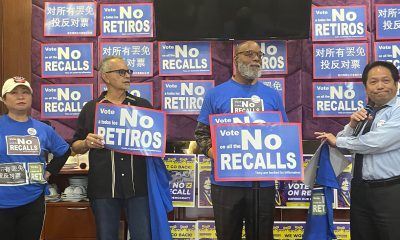
 Activism3 weeks ago
Activism3 weeks ago‘Respect Our Vote’ Mass Meeting Rejects Oakland, Alameda County Recalls
-

 California Black Media2 weeks ago
California Black Media2 weeks agoStudy: UC 4-Year Grad Rate Doubles That of CSU
-
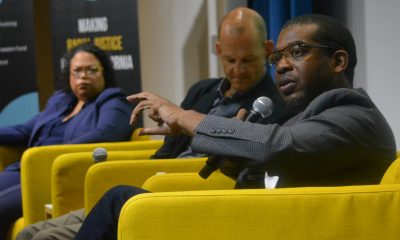
 Bay Area2 weeks ago
Bay Area2 weeks agoState of Black California: Oakland Tour Stop Rescheduled
-
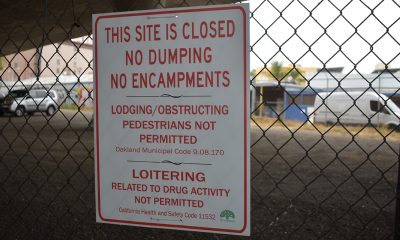
 Bay Area2 weeks ago
Bay Area2 weeks agoMayor Sheng Thao Issues Executive Order to Shut Down Homeless Encampments
-

 Alameda County2 weeks ago
Alameda County2 weeks agoAlameda County Democratic Party Opposes the Recall of Mayor Sheng Thao
-

 Bay Area2 weeks ago
Bay Area2 weeks agoFormer Mayor Willie L. Brown Endorses Dana Lang for BART Board District 7


























































